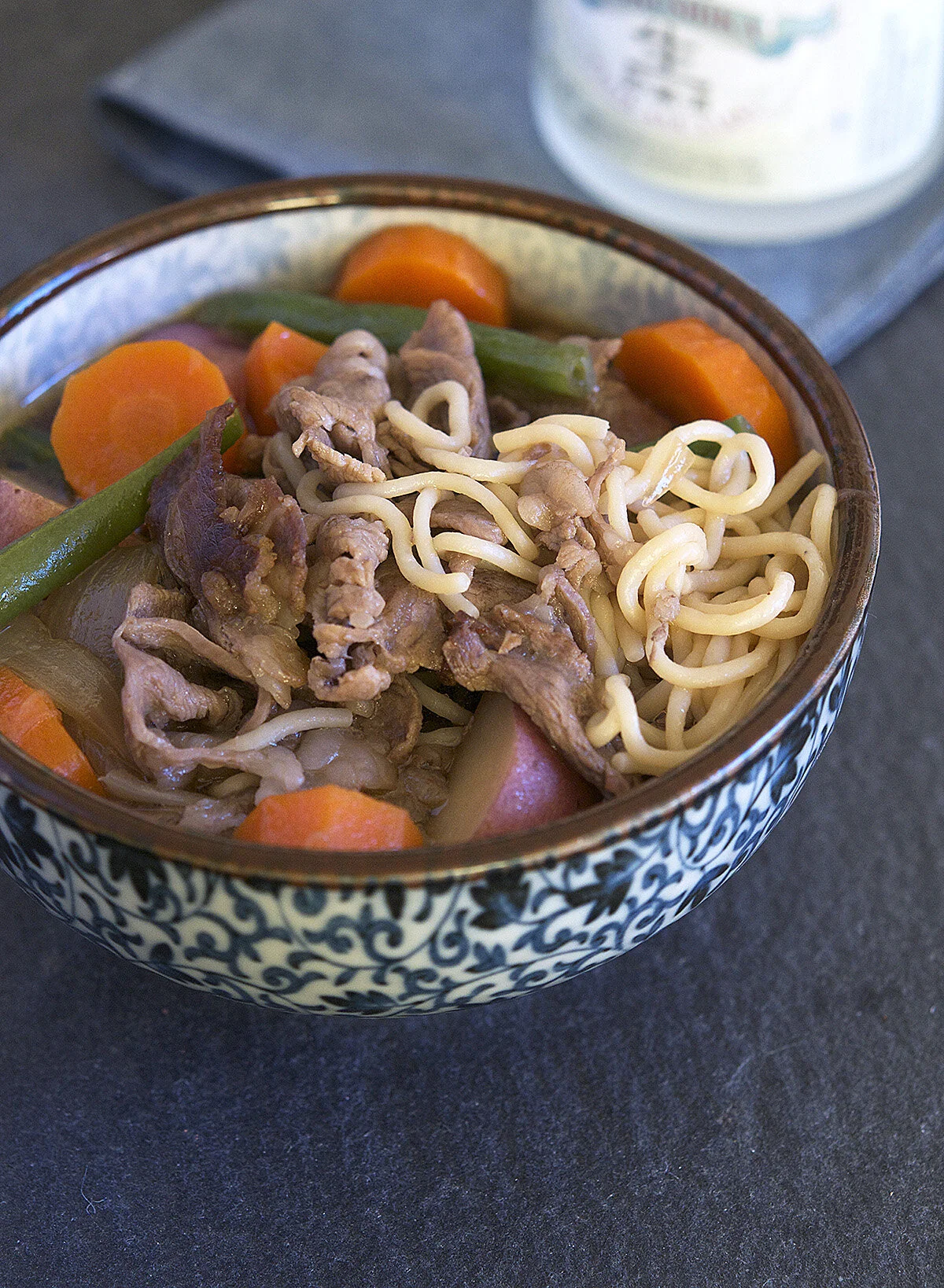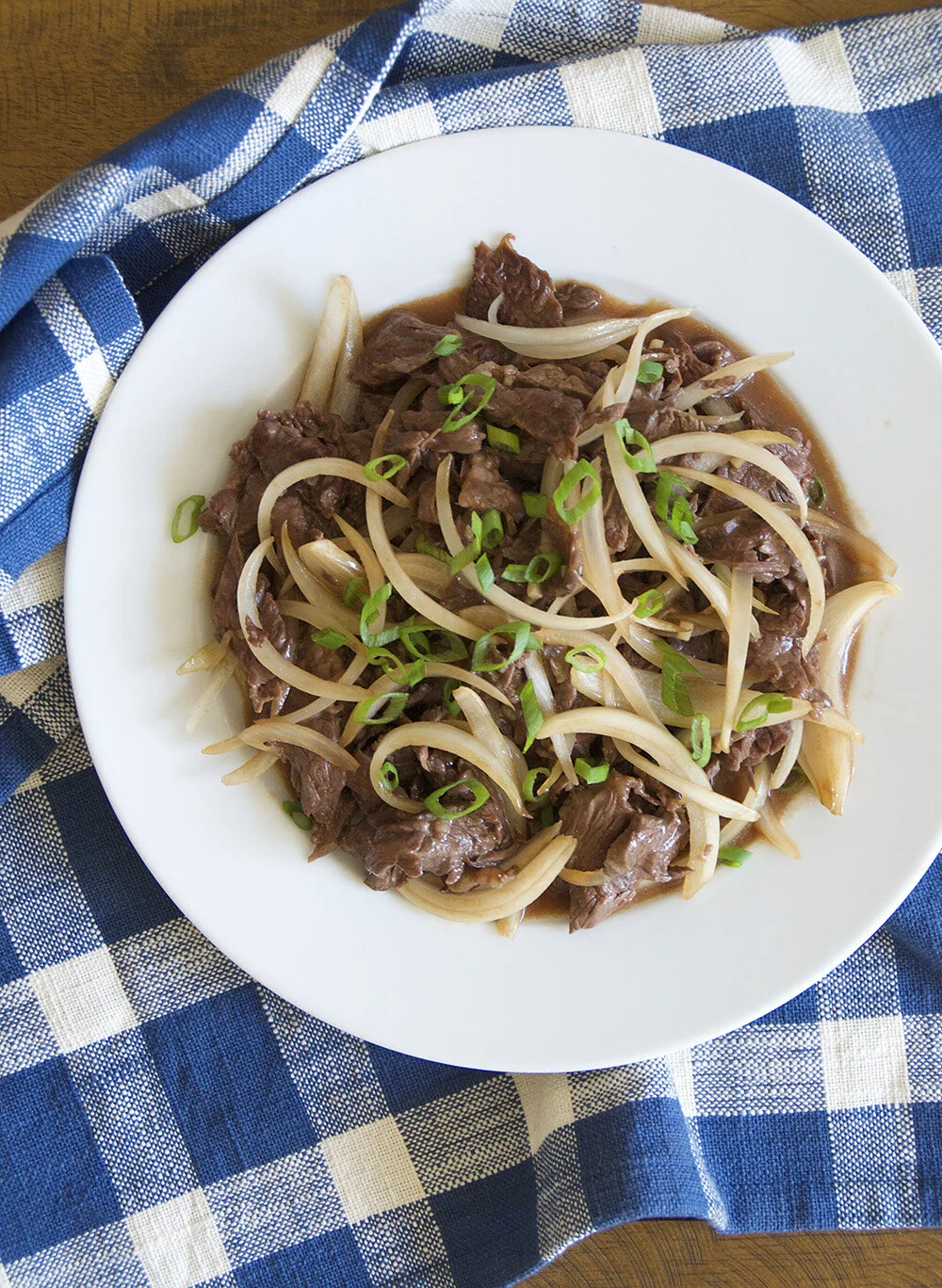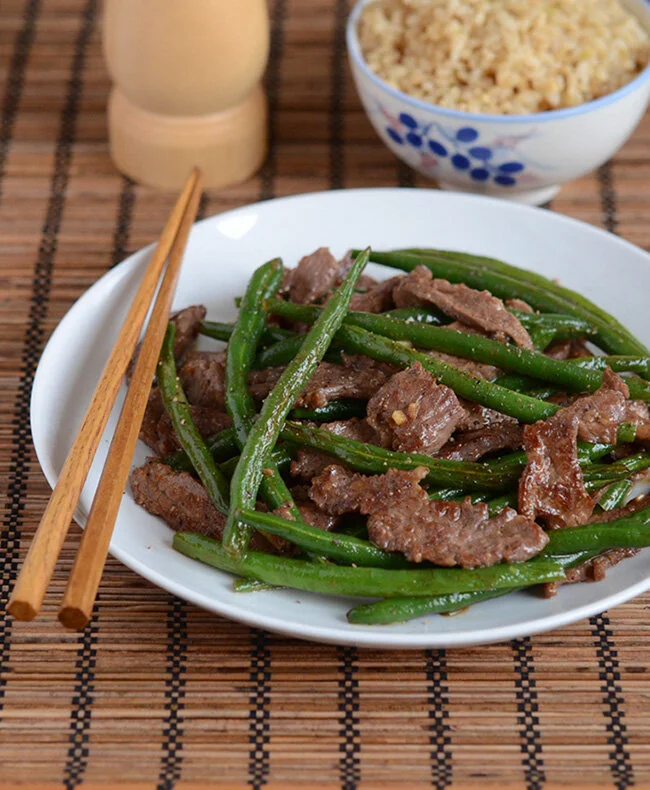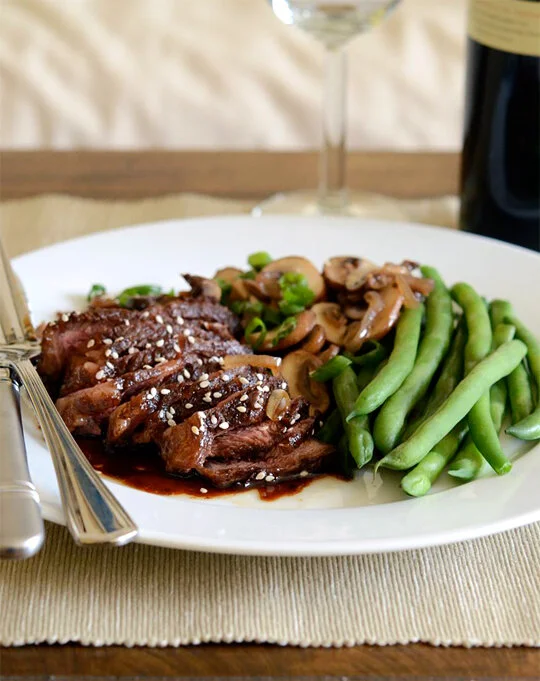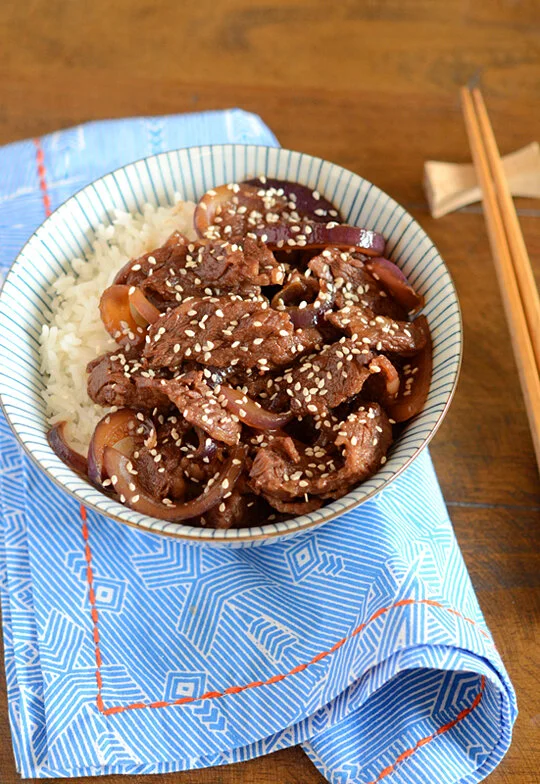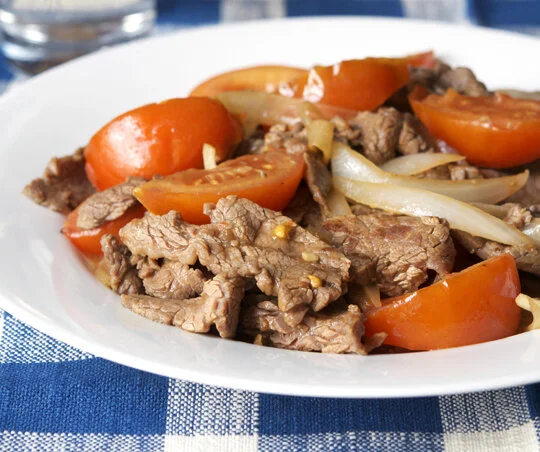This is a hearty stew that you can whip up in about 40 or 50 minutes, including prep time.
Read MoreThis easy and delicious stir-fry uses a velveting technique to get super-tender beef.
Read MoreThe ingredients are minimal but the flavor is outstanding.
Read MoreKorean beef and kimchi are words that are like music to my ears.
Read MoreSpring weather has been slow to arrive this month. Yet I've been craving spring veggies like crazy. In the coming weeks, asparagus will start popping up in the farmers markets, so I thought I would post a stir-fry to get you in the mood for warmer temps ahead.
As I've mentioned before, lately I've been testing out sauces from Soy Vay, with whom I started a partnership in January. This month I decided to try out their recipe for a garlic beef and asparagus stir-fry using their Hoisin Garlic. Here are some discoveries from the Appetite for China test kitchen:
- Doubling as a marinade, this is one workhorse of a sauce. I altered the original recipe a bit, marinating the beef in about 2 tablespoons of Hoisin Garlic to allow the flavors to seep into the meat before cooking. The result was incredibly tender beef; the sauce takes the place of my usual meat marinade of soy sauce, rice wine, and cornstarch.
- It's a little less concentrated than other hoisin sauces I've used, which makes it easier to stir in the pan. This is especially helpful for this recipe, because the flank steak cooks so quickly, and you don't want to overcook the beef before the sauce gets evenly mixed.
- The flavor is slightly sweeter, which balances out the savoriness from the soybeans. No need to add an extra bit of sugar to your sauce, which I often do.
Red-cooked beef is one of those dishes that is just made for the winter. This Chinese beef stew — made by simmering well-marbled beef in a combination of soy sauce, cinnamon, star anise, tangerine peel, and chilies — is as aromatic and delicious as it sounds.
Plus, the bubbling action and warmth in the kitchen while you make this dish is a huge plus when it's 19 degrees F out and your radiator isn't working as well as it should.
Some of you may have tried making red-cooked pork before from this site. My method for red-cooked beef is similar, with some key differences. One big difference is the addition of dried tangerine peel. You can choose to include it or not, but I find that orange flavors pair so well with beef, and adds such a wonderful citrus fragrance to the stew, that I can't pass it up.
You can buy tangerine peel in any Chinese market, but it's also easy to make your own at home. Just peel a tangerine (reserving the insides for a snack!), rip the peel into large pieces, and keep the pieces on a windowsill or another cool, dry spot for 2 to 3 days. Or, to dry the peels on short notice, bake the peels in a 200 degree F oven for about 60 to 70 minutes, until they dry up and look like the peels in the photo above.
Read MoreEver since my annual check-up this past summer, I've been looking for ways to incorporate more iron into my diet. Fortunately, Chinese beef stir-fries are pretty healthy as far as red meat dishes go, because the meat is usually paired with vegetables and the sauces are flavorful yet light. (That is, if you make them at home instead of ordering from the local take-out.)
And of course, beef with broccoli is probably the most popular and beloved takeout dishes in this country. I mean, if you're a red meat eater, how can it not sound good? Succulent, tender strips of beef mixed with tender-crisp broccoli? I'd crave it any time. It's an easy one-dish entree (with rice on the side, of course) from which you can get a ton of nutrients.
So here's a pumped-up take on the classic dish that includes fragrant sesame oil, a bit of Worcestershire sauce, and optional chili sauce for a little kick. (A note on Worcestershire sauce, since some of you have asked: yes, it is a common ingredient used in Chinese cooking, especially Cantonese. We've been using it for well over a century, since the British colonial days in Hong Kong, to enhance the meatiness in stir-fries and noodle dishes.) Try it out anytime you'd like to get something fast, healthy, and delicious on the table!
Read MoreA good teriyaki dish, whether it's steak, chicken, or salmon, relies on just a few ingredients to create the deep, complex flavor.
Read MoreGyudon (Japanese Beef and Rice Bowl ) is pure comfort food for me. The ingredients are simple but result in the sauce that’s sublime.
Read MoreIt's tempting to make only salads for lunch and dinner during the summer. When the temperatures are so high that the mere thought of turning on the stove makes you break out into a sweat, salads just sound so darn easy. Wash some salad greens, toss in some nuts and olives and cheese, whisk together some vinaigrette, and you're good to go. Add some bread and cold cuts to the side and you've got a complete meal.
Of course, there's that monotony thing. As much as I like routine, it's hard to go months or even weeks eating the same things at home. So that's why I also have a list of quick stir-fry dishes in my summer cooking arsenal too. All these main dishes require minimal prep time and less than 10 minutes in front of the stove.
And what are some of these dishes? Shellfish, which takes mere minutes to cook, is always a winner. One of the easiest and fastest dishes I like to make is Shrimp with Spicy Garlic Sauce, which takes about 5 minutes. If you're not into spicy dishes, there's also Sake-Steamed Clams and Shrimp Lo Mein. In the chicken category there's Kung Pao Chicken, Almond Chicken, and Vinegar-Glazed Chicken.
Read MoreOne of the best parts about revisiting recipes from previous years is seeing how little changes can make a big difference. Take, for example, this Spicy Hunan Beef with Cumin dish. The version from June 2010 involved fresh red chilis with crushed red pepper flakes. Over the weekend, I tweaked the recipe with dried red chilis with chili oil and a bit of chili sauce. The result was an even better dish, with a hint of smokiness from the dried red chilis and chili oil that the first version didn't have. It'll be my go-to version from now on.
When I moved into my new apartment a few months ago, the first thing I did was take inventory of the cupboards. (The previous tenants had left a decent supply of spices, oils, and condiments.) The second thing I did, even though it was almost 10pm by the time I was done unpacking, was march over the Trader Joe's and buy ground cumin. I had not planned on cooking that night. It just made me sleep better, knowing my kitchen was no longer egregiously understocked.
Other than sea salt, cumin is the spice that I cannot with without. If I were only allowed two spices on a deserted island (with an otherwise fully-stocked kitchen), and had to choose between cumin and a pepper grinder, the former might win out. Just a whiff of toasted cumin seeds brings back a flood of memories of the best foods I have ever eaten: melty lamb shoulder from a Yemeni restaurant in Brooklyn, late night beef kebabs from a street vendor in Beijing, or pilau from an Afghani restaurant near Boston.
Read MoreCantonese tomato beef, a Hong Kong classic, is great for nights when you need a fast dinner.
Read MoreBack when I made black pepper beef in Beijing, flank steak was surprisingly difficult to find. Sure, black pepper beef is more of a Cantonese stir-fry, and the Chinese eat pork way more than beef, but somehow I just didn't expect to have to buy all my flank steak at a gourmet market for expats. Luckily, now I'm back in Brooklyn and living within walking distance of at least five big grocery stores, all of which have flank steak in abundance.
Over the years I've altered my recipe (first published July 27, 2008) to include ground black pepper in the sauce instead of the marinade, so the flavor is now more pronounced. The proportions of the sauce ingredients have also been updated; this sauce has less sodium, less sugar, less oil, but still maintains plenty of flavor. Try it out and let me know what you think!
Flank steak is something I hardly ever cook in China, mostly because I am almost never in the vicinity of a good butcher. But last weekend, I decided to treat myself to a massage to help with a sore back. Walking out blissful and somewhat painfree, I realized I was near Boucherie Michel, the only place in town where I could find quality cuts of meat and imported cheeses and wine and pricey organic food. (How I miss the days when I could pop down to the Fairway in West Harlem for all my grocery needs.)
Read MoreSlow-cooking meat in a nice enamelled cast iron Dutch oven is a pretty sublime experience. I've done my fair share of braising in metal pots, woks, Crock-Pots, and even sauté pans, but really, nothing compares to the ease of searing and stewing everything in the same pot, and one that needs minimal heat to stay bubbling hot. When most of your favorite dishes (boeuf bourguignon, coq au vin, chicken adobo, red-cooked pork) are braises or stews, you start salivating over the Le Creusets and Staubs upon entering any kitchen supply store.
I've used Le Creusets a good number of times when teaching at cooking schools, but hadn't actually own a proper Dutch oven until now. This Christmas I received a lovely red Staub "cocotte" from my chief taste tester/bf and have been using it as much as possible. (A great present, by the way, for someone craves chicken adobo every other day and can make it in her sleep.)
Read MoreI've been thinking a lot recently about how the names of Chinese foods vary so much between China and the US.
One example is lemon chicken. In Southern China, lemon chicken usually means a whole bone-in chicken, steamed, chopped up, and served with a light lemon sauce. In the US, you'd get perfect cubes or slices of breast meat that has been fried and coated with a thick lemon sauce. (In other words, more like this.) A few places, like this takeout spot in Park Slope, may serve you something that looks like a lemon chicken kit that you put together: breaded and fried chicken with little seasoning, on top of some iceberg lettuce, and a container of something that's more or less lemon simple syrup.
Another example is Mongolian beef. In Beijing, Mongolian-style lamb or beef is stir-fried with toasted cumin seeds and whole red chilis. In the US, what has become Mongolian beef lacks any whole spices, but is pretty tasty in its own right. The only thing similar to its mainland Chinese cousin is the thinly sliced steak and abundance of leeks. The sauce, when done well, is pretty terrific. The beauty of Mongolian beef sauce is that none of the flavors stand out on their own, but rather, come together (as the Chinese would say) "harmoniously".
Read More
